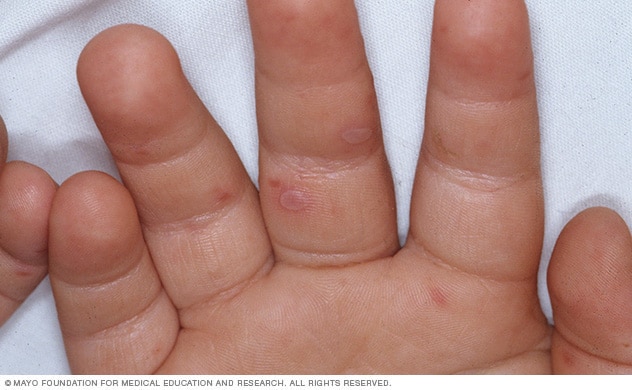As the late spring rains have begun to fade and the temperature rises mercilessly into the 80s and beyond, summer is finally upon us. And with summer comes a host of diseases for the emergency physician to consider. Heat stroke, mosquito- and tick-borne illnesses, chicken pox, an expanding measles outbreak…and a less threatening cause of little spots in the mouth: coxsackie virus, the major etiology of hand, foot and mouth disease (HFMD).
HFMD and its mouth-only cousin, herpangina, are caused by several species of the Enterovirus genus, predominantly serotypes of coxsackievirus and enterovirus, and less so echovirus. Like most peds viral infections, HFMD is a clinical diagnosis – sores on the oral mucosa (typically on the tongue and buccal mucosa), a macular or vesicular rash on the hands and feet (typically not painful or itchy), and possibly a low-grade fever. Herpangina is characterized by high fever and a “painful papulo-vesiculo-ulcerative oral enanthem,” certainly my favorite derm term of the day. Most commonly these illnesses are seen in infants and children under five, although cases in older kids and adults do occur.

Those infected are contagious mostly during the first week of illness, or until open sores are resolved; HFMD is spread via fecal-oral route, respiratory secretions and blister fluid. Hand hygiene is number one here. As with the other 97% of our favorite peds diagnoses — Acute viral syndrome, Nonspecific syndrome suggestive of viral illness, Unspecified viral URI, Nonspecific exanthematous viral infection, and Other viral infections of unspecified site — most cases of HFMD are benign, self-limiting and treated with supportive care. Fluids, antipyretics and OTC analgesia prn, and time. Consider magic mouthwash for mouth/throat pain. The majority of HFMD cases last 7-10 days at most and can be discharged home safely.
Complications of HFMD are rare and usually caused by two particular serotypes, enterovirus A71 and coxsackievirus A6. The former can lead to CNS disease (encephalitis, acute flaccid paralysis, aseptic meningitis) and myocarditis; the latter to severe presentations of HFMD, including more widespread lesions, higher fevers, longer duration. Consider advanced workup, IV hydration, and inpatient treatment in these cases.


References:
Romero, JR. Hand, foot, and mouth disease and herpangina. UpToDate. Accessed June 6, 2019.
Centers for Disease Control and Prevention. Hand, Foot, and Mouth Disease. https://www.cdc.gov/features/handfootmouthdisease/index.html
Hand-foot-and-mouth disease. https://www.mayoclinic.org/diseases-conditions/hand-foot-and-mouth-disease/symptoms-causes/syc-20353035
